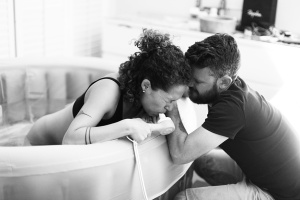Between 28 and 40 weeks you’re on the countdown to meeting your baby. Here’s what you need to know about that final third.
1. Your baby will still be moving
Place a hand on your partner’s tummy and you should still be able to feel your baby moving. They’ll move even more between 29 and 32 weeks of pregnancy.
At 32 weeks, movement will plateau but ignore anyone who says you can expect movement to stop after that. It’s a myth. Your baby should carry on moving until they are born (Tommy’s, 2018).
2. That all-important sucking reflex is developing
Your baby is getting ready to come out and drink their milk. Their sucking reflex is developing between weeks 29 and 32 (NHS Choices, 2017a).
Other developmental milestones around now are your baby’s eyes starting to focus, and their brain and nervous system developing around week 33. Their bones are also starting to harden around this time, apart from their skull bones (NHS Choices, 2017b).
By 36 weeks your baby’s lungs will be fully formed and their digestive system prepared for milk (NHS Choices, 2017b).
3. At 37 weeks, they are officially ready for the world
Once your baby reaches 37 weeks, they’re considered full term. So from then on your child is ready to be born (NHS Choices, 2017c).
4. Your baby is now getting ready for birth
At 32 weeks, babies are usually lying with their head pointing down, in position for labour (NHS Choices, 2017a). If not, your midwife will speak to you about how you can help them along to change position.
5. What your partner might be going through during the third trimester
- Breathlessness – the baby is pushing up against her lungs and the extra weight she is carrying doesn’t help either.
- Leg cramps and difficulty sleeping – are very common when finding a comfortable sleeping position is so hard.
- Back pain – your partner’s ligaments have naturally become softer to prepare for labour, which can put a strain on her lower back and pelvis, causing her pain.
- Braxton Hicks – this is when your partner’s uterus tightens, with her uterus practising for the tightening or contractions of labour.
- Swollen feet, face, or hands – these symptoms probably won’t make her feel very glamorous, they’re caused by water retention.
(NHS Choices, 2017a; NHS Choices, 2018a)
6. How to help your partner
- Share, or even better do the majority of, the housework and give your partner time to rest if she needs it.
- Do the heavy lifting so your partner can give her back a rest.
- Encourage her to rest with her legs up to ease the water retention and swelling.
(NHS Choices, 2017d)
7. The hospital bag
If your partner is planning on giving birth at hospital or at a midwifery unit, she should have her bag ready at least two weeks before her due date (NHS Choices, 2018b). You can help your partner get this ready, and can find a list of things that she might need here.
Your baby will also need some things packed. Things you can pack for your baby include clothes, hat, mittens, booties, nappies, blankets, muslin squares and a car seat if you have a car (NHS Choices, 2018b).
But don’t forget about yourself, especially if you are staying overnight. In your bag, pack some loose change (if needed) for parking, toiletries, a change of clothes, phone, charger and glasses if needed. Some swimming trunks might be useful for you in case your partner goes into the pool.
You might also want something to pass time in case labour takes a while, which it might if your partner has an induction. For example, take a book or iPad with films loaded on to it.
Once your partner’s due date is near, keep your phone charged, close by and save any crucial numbers like the hospital or midwife.
8. Stock up and get everything ready at home
Load the cupboards up before your partner gives birth. When the baby comes, you might all feel like hibernating for a while instead of queuing at the supermarket. Stock up on toilet paper, maternity pads, nappies, formula (if using) and pre-cooked meals in the freezer.
Have you organised somewhere for the baby to sleep? Now's the time to get with a new mattress and clean bedding, ideally a Moses basket next to your bed in your room.
9. Know the route
One of the first vital bits of kit you’ll need is a car seat for the baby if you’re driving home. Practise fitting it before you put your baby in it for the first time as it can take a while to get the hang of it. Plan your route to the hospital or midwifery unit where your partner will be giving birth. You’ll also want to make sure that the car has plenty of fuel if you’re driving.
If you are taking the baby home via public transport, you’ll need a pram or buggy. It's a good idea to think about your route and step-free access, for instance.
10. Know the signs of labour
It’s useful for dads-to-be to know about the signs of labour. That way you are both prepared. Look out for:
- contractions
- a ‘show’ – plug of mucus coming away from your partner’s cervix
- your partner really needing the toilet
- her waters breaking
- your partner having backache.
(NHS Choices, 2017e)
Your midwife might advise your partner to stay at home until her contractions are coming more closely together (NHS Choices, 2017e). Once contractions last at least 60 seconds, and come every five minutes, you should call the midwife. They can advise you whether you need to go to hospital or stay at home a while longer and relax.
This page was last reviewed in March 2017
Further information
Our support line offers practical and emotional support with feeding your baby and general enquiries for parents, members and volunteers: 0300 330 0700.
We also offer antenatal courses which are a great way to find out more about birth, labour and life with a new baby.
Make friends with other parents-to-be and new parents in your local area for support and friendship by seeing what NCT activities are happening nearby.
NHS Choices. (2017a) You and your baby at 29-32 weeks pregnant. Available from: https://www.nhs.uk/conditions/pregnancy-and-baby/pregnancy-weeks-29-30-31-32/ [Accessed 28th March 2017].
NHS Choices. (2017b) You and your baby at 33-36 weeks pregnant. Available from: https://www.nhs.uk/conditions/pregnancy-and-baby/pregnancy-weeks-33-34-35-36/ [Accessed 28th March 2017].
NHS Choices. (2017c) You and your baby at 37-40 weeks pregnant. Available from: https://www.nhs.uk/conditions/pregnancy-and-baby/pregnancy-weeks-37-38-39-40/ [Accessed 28th March 2017].
NHS Choices. (2017d) Pregnancy, birth and beyond for dads and partners. Available from: https://www.nhs.uk/conditions/pregnancy-and-baby/dad-to-be-pregnant-partner/ [Accessed 28th March 2017].
NHS Choices. (2017e) Signs that labour has begun. Available from: https://www.nhs.uk/conditions/pregnancy-and-baby/labour-signs-what-happens/ [Accessed 28th March 2017].
NHS Choices (2018a) Swollen ankles, feet and fingers in pregnancy. Available from: https://www.nhs.uk/conditions/pregnancy-and-baby/swollen-ankles-feet-pregnant/[Accessed 28th March 2017].
NHS Choices. (2018b) Pack your bag for labour. Available from: https://www.nhs.uk/conditions/pregnancy-and-baby/pack-your-bag-for-birth/ [Accessed 28th March 2017].
Tommy’s. (2018) Baby movements in pregnancy. Available from: https://www.tommys.org/pregnancy/symptom-checker/baby-fetal-movements [Accessed 28th March 2017].







